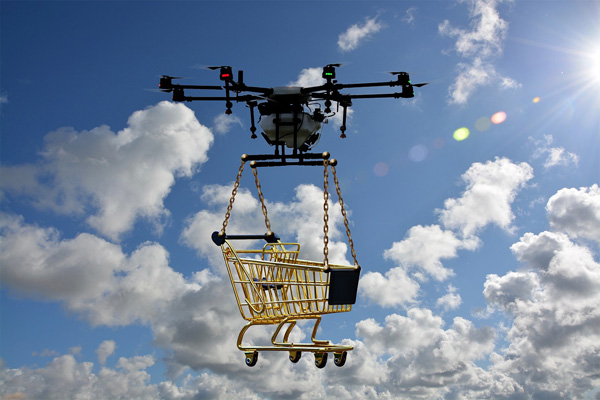Drone package delivery market to hit $33.4B by 2030, report predicts

[A drone carrying a miniature golden shopping cart through the sky. Image from Pixabay]
According to the "Drone Package Delivery - Global Strategic Business Report" by Research and Markets, the global drone delivery market is projected to expand to $33.4 billion by 2030, driven by advancements in technology, rising demand for faster deliveries, and increasing commercial adoption.
Currently valued at $5 billion in 2024, the industry is forecasted to grow at a 37.3% compound annual growth rate (CAGR) over the next six years, driven by technological advancements, increased demand for rapid deliveries, and regulatory support.
The short-duration delivery segment (below 30 minutes) is projected to grow significantly, reaching $18.1 billion by 2030, with a 36% CAGR.
Meanwhile, the long-duration segment (30 minutes and above) is expected to expand even faster, at 38.9% CAGR.
These advancements will enable drones to cover greater distances and carry heavier packages, making them a viable alternative to traditional delivery services.
The U.S. market, valued at $1.5 billion in 2024, remains the global leader in drone delivery adoption.
However, China’s market is expected to surge, growing at a 34.8% CAGR to reach $4.6 billion by 2030.
Other key regions, including Japan, Canada, Germany, and the Asia-Pacific, are also making substantial investments heavily in drone delivery infrastructure.
The rapid expansion of drone delivery services is fueled by several key factors.
Advancements in AI and navigation technology have enabled drone efficiency, allowing for autonomous flight, real-time obstacle avoidance, and optimized delivery routes.
These technological improvements boost safety and expedite faster deliveries.
Government regulations are also playing a crucial role in the sector’s growth.
Many countries are establishing comprehensive aviation guidelines to ensure drones operate safely, particularly in populated areas.
This regulatory clarity is encouraging wider adoption by businesses looking to integrate drones into their logistics networks.
The rise of e-commerce has further fueled demand for drone deliveries.
Major companies such as Amazon, DHL, and UPS are investing in drone technology to meet consumer expectations for faster and more reliable shipping options.
As online shopping continues to grow, drones offer a practical solution for quick and efficient last-mile deliveries.
Sustainability is another key driver of drone delivery adoption.
Electric drones offer an eco-friendly alternative to traditional fuel-powered delivery vehicles.
By reducing carbon emissions and cutting down on road congestion, drones support corporate environmental goals while improving delivery efficiency.
Looking ahead, drone delivery is expected to revolutionize logistics, particularly in medical supply transport, remote area deliveries, and congested urban centers.
As technology advances and regulatory frameworks continue to evolve, businesses and consumers will increasingly depend on drones to streamline last-mile delivery operations.
Despite rapid expansion, the drone delivery industry faces several challenges.
Regulatory hurdles remain a major barrier, as governments carefully assess airspace safety, privacy concerns, and noise pollution.
Countries with stringent aviation laws, such as those in Europe, are moving cautiously in allowing widespread drone deliveries.
Operational costs and battery limitations also pose challenges.
While AI and automation improve efficiency, establishing and maintaining drone fleets require significant investment in infrastructure, maintenance, and logistics coordination.
Weather conditions can also impact reliability, as strong winds and rain disrupt flight operations.
Nonetheless, industry leaders remain optimistic.
Experts predict that improvements in battery life, AI-driven route optimization, and expanding 5G networks will enhance drone performance.
As adoption increases, economies of scale are expected to lower operational costs, making drone delivery a mainstream option for businesses and consumers alike.

- Junyi Seo / Grade 11
- Seoul Academy

![THE HERALD STUDENT REPORTERS [US]](/assets/images/logo_student_us.png)
![THE HERALD STUDENT REPORTERS [Canada]](/assets/images/logo_student_ca.png)
